Yoga Research: Is Yoga Helpful for Fertility?
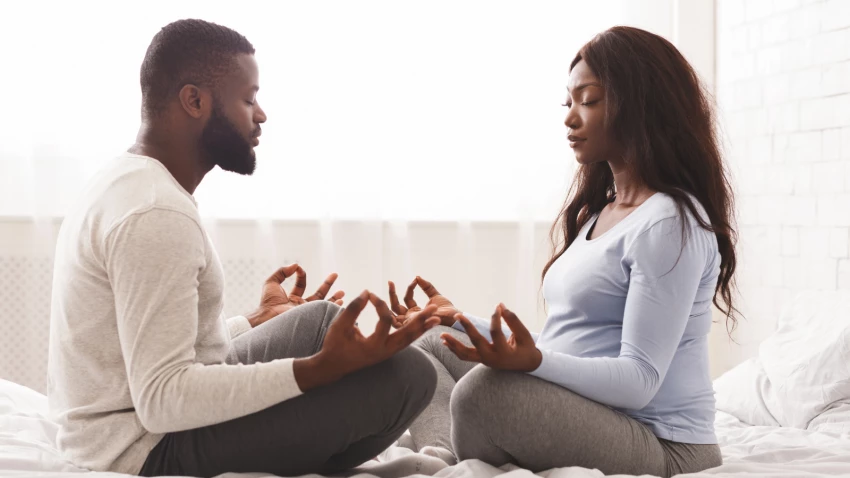
What does the research say about yoga for fertility? This article explores the latest research on the topic and outlines a grounding fertility yoga sequence.
How common is infertility? It’s more widespread than you may imagine. According to the Centers for Disease Control, about 12 percent of women in the U.S. between ages 15 to 44 have difficulty getting or staying pregnant.
And among couples in which the woman is 35 or older, infertility is reported by about one in six. This statistic is significant because fertility trends point to women having children later in life compared to past generations. Delaying pregnancy can result in various benefits for families, such as gaining maturity, establishing adequate financial resources to raise a family, and enabling parents to establish their careers. Nonetheless, infertility can be a concern to couples in their 30s who dream of starting a family.
What Causes Infertility?
Age can result in difficulty getting or staying pregnant for some couples in which the woman is over 35 due to a diminished supply of healthy eggs. But age is by no means the only cause of infertility. In about 35 percent of couples, infertility can be attributed to an issue in both partners, while for some couples, the cause of infertility can’t be identified.
Medical practitioners often advise couples trying to conceive to make lifestyle changes to improve their chances of getting and staying pregnant. Losing excess weight, giving up smoking, or cutting back excessive alcohol intake are all among the common lifestyle modifications advised by doctors. In addition, research is beginning to recognize the significance of the close connection between physical or emotional stress and infertility (1).
Stress and Infertility: A Vicious Cycle
How does stress raise someone’s risk of infertility? More research is needed to understand the physiological mechanism behind stress and infertility, but scientists believe it is related to stress’s impact on reproductive hormones. Emotional stress is known to raise cortisol levels, a hormone associated with the fight-or-flight response. This can disrupt the normal functioning of the endocrine system, which is responsible for secreting the hormones necessary for ovulation. Specifically, cortisol may cause an increase or premature secretion of the reproductive hormone luteinizing hormone (LH), which can lead to irregular ovulation, abnormal ovulation, or amenorrhea (absence of menstruation).
In addition, physical stress related to excessive exercise and caloric restriction can affect the menstrual cycle by interfering with the secretion of gonadotropin-releasing hormone (GnRH) from the hypothalamus. This, in turn, leads to the suppression of reproductive hormones LH and follicle-stimulating hormone (FSH). When the body faces intense physical activity and caloric deprivation, it chooses to shunt its resources toward survival over less crucial functions like reproduction. This process is similar to putting on one’s oxygen mask before securing one on a child.
Unfortunately, in many cases, when stress contributes to infertility, it leads to a vicious cycle of increasing stress and reduced risk of fertility that is difficult to exit. According to one study from Harvard Medical School, about 40 percent of women experiencing infertility report anxiety, depression, or both (1). This mental health burden is comparable to levels of anxiety and depression reported by patients with chronic, life-threatening conditions like cancer and HIV/AIDS.
Yoga for Fertility: A Tool for Stress Reduction
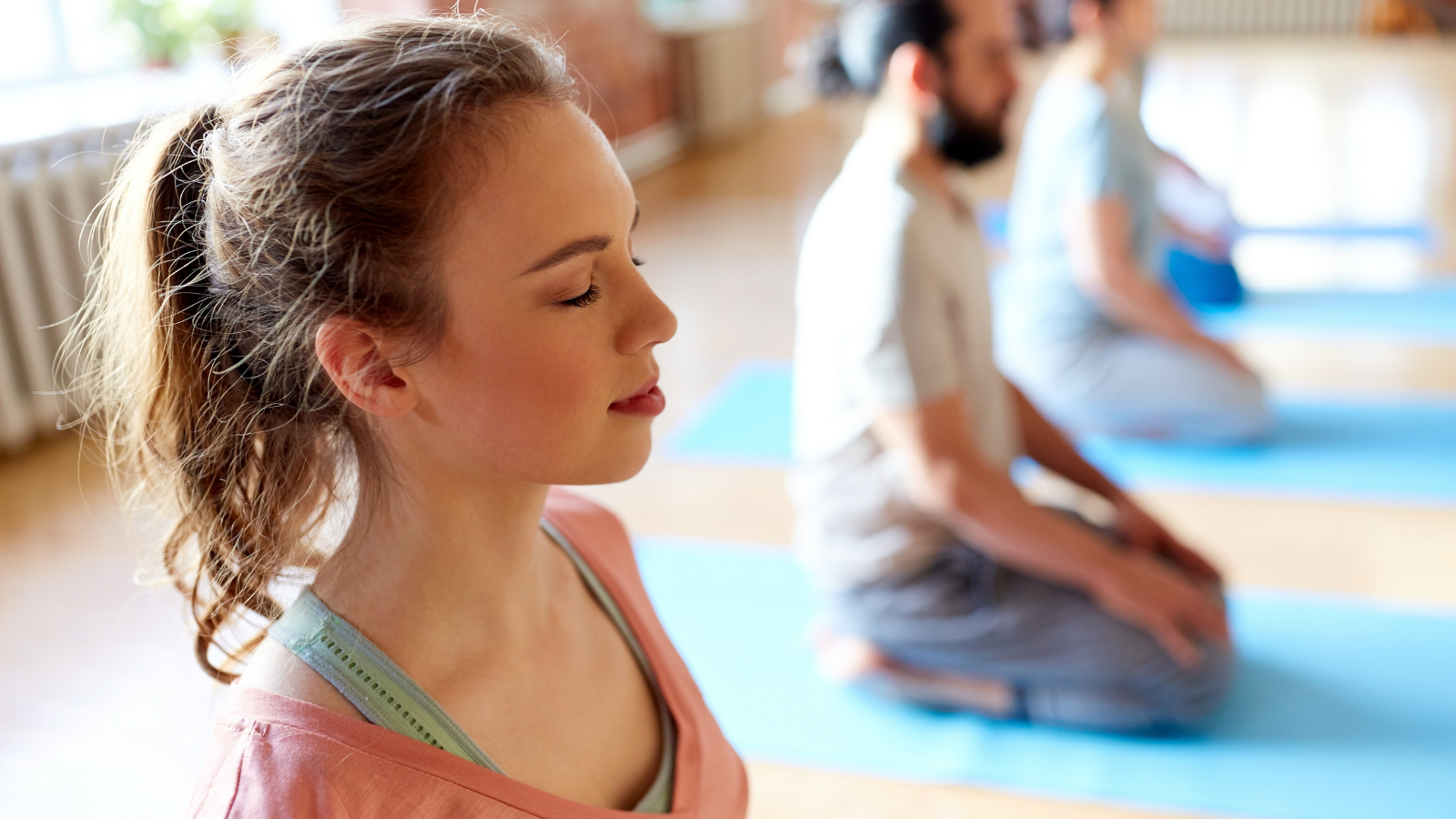
Being unable to get or stay pregnant for families who desire to bring a child into the world can feel as though their chance of conceiving is far beyond their control. But the good news is that the effects of stress on reproductive functioning are generally reversible. Once the period of intense physical or emotional stress ends, regular ovulation can return.
And yet, being told by a doctor to “relax” may only cause couples more distress if they don’t have the tools necessary for stress reduction. What’s more, the topic of infertility is still highly stigmatized. This may lead to a need for supportive communities where couples can openly speak about their fertility journey. Thankfully, yoga for fertility may serve as a beacon of hope for some who struggle with infertility.
Results of an RCT on Yoga for Fertility

Perhaps the most promising research on yoga and fertility is an RCT randomized controlled trial led by Alice Domar and colleagues at Harvard Medical School (2). In this study, a total of 143 women aged 40 or older experiencing infertility who were about to begin their first round of in-vitro fertilization (IVF) were randomized to participate in 10 sessions of a mind/body program or to a control group. The authors found that 55 percent of women who participated in the mind/body program became pregnant and gave birth within one year of completing the program, compared with 20 percent in the control group. This significant difference led the authors to conclude that participation in the mind/body program aimed to reduce stress was associated with an increased rate of pregnancy compared to the control group.
Other studies have supported yoga as a safe practice for stress reduction among women experiencing infertility. For example, in a pilot study performed by Valoriani and colleagues (3), 90-minute Hatha Yoga classes were offered to 143 women for three months prior to undergoing IVF. Among these women, 45 women chose to participate in the classes. These women reported lower stress levels at the end of three months of class participation compared to baseline. There was no difference in stress levels reported by the 75 women who did not participate.
Additional Research on Yoga for Fertility
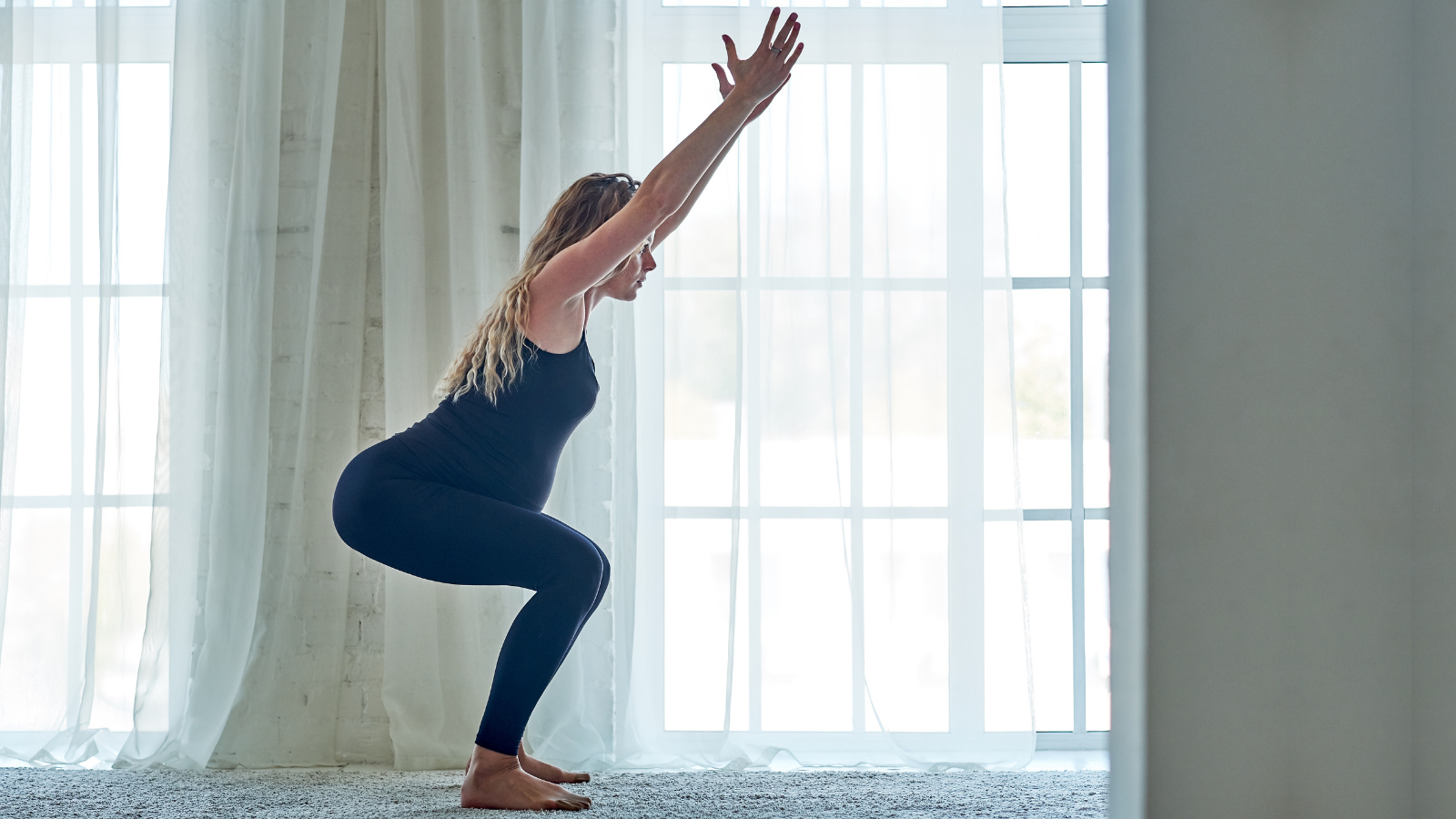
Similar results were also found in a feasibility study by Jasani and colleagues (4), who offered an intervention including six weeks of yoga and a discussion group to 111 individuals undergoing IVF. Among the 55 individuals who participated in the yoga classes, self-reported anxiety decreased by 20 percent compared to baseline. There was no significant change in the control group.
These two studies (3 and 4) were both included in a review article by Darbandi and colleagues (5) that provides a comprehensive view of 87 scientific studies on yoga’s impact on fertility. In addition to decreasing stress among women undergoing IVF, this review highlights other potential benefits of yoga for couples using assisted reproductive technology. These benefits include reduced pain during labor and pregnancy, decreased assisted vaginal delivery, improved fetal outcomes, and reduced stress among male partners.
Although additional rigorous research is needed to understand the full effects of yoga on fertility, taken together, the current research points to yoga as a safe and effective way to reduce stress among couples seeking treatment for infertility.
Effective Styles of Yoga for Fertility
What type of yoga may be best for individuals hoping to get or stay pregnant? The current research available points to a practice that is gentle and that cultivates connection with the community. Anecdotal accounts from hundreds of women who have become pregnant after participating in programs at fertility centers like Pulling Down the Moon in Chicago support this type of practice.
If you are experiencing trouble getting or staying pregnant, check with your doctor before beginning a fertility yoga program. Especially for individuals undergoing IVF, medical professionals may recommend even more gentle physical activity than yoga. And, of course, practicing yoga will likely not solve diagnosable medical issues that cause infertility, such as uterine abnormalities or early menopause. But for anyone who has received the stamp of approval from their doctor, it may be worthwhile to sign up for a fertility yoga program, join a fertility support group, or try practicing gentle yoga, such as the restorative practice outlined below.
How to Practice Yoga for Fertility
Yoni Mudra in Easy Sitting Pose (Sukhasana)

- Begin this practice by taking a comfortable cross-legged seat in an Easy Sitting Pose (Sukhasana) on 2 to 3 folded blankets or a cushion. Sitting cross-legged is an effective way to gently open the hips. But if this posture causes any pain or discomfort in the knees or ankles, sit in a supported Hero’s Pose (Virasana) or on a chair instead.
- Once you are grounded in your seat, join your hands into Yoni Mudra by touching your thumbs together so they point upward toward your heart, touching your pointer fingers together so they point down toward the earth, and curling your last three fingers in toward your thumbs. This gesture is dedicated to Shakti, the primordial feminine energy in Hindu mythology, and symbolizes the womb, creation, and the source of life.
- Keeping your hands in Yoni Mudra, place them on your lower abdomen just below the navel center.
- Close your eyes, and on an inhalation, breathe down toward the lower abdomen, visualizing the warmth of your hands, meeting the cool air that is being drawn downward. Let your exhalation follow naturally. Repeat for about 20 rounds, breathing in and out through your nose.
Hip Circles in Tabletop Pose (Bharmanasana)

- Open your eyes and move forward to all fours with your wrists stacked under your shoulders and knees below your hips. Place a blanket under your knees if you need additional padding to allow for physical ease.
- Lead with your hips as you begin to slowly circle your body in a clockwise motion. Repeat for about eight circles in this direction, closing your eyes as you circle if this invites additional freedom in your movement.
- Repeat an additional eight circles, moving in a counterclockwise direction.
- After repeating these circles in both directions, make any additional movements that your body craves from all fours. This could mean taking a few rounds of Cat/Cow Pose (Majaryasana/Bitilasana) or barrel rolls of the chest.
Restorative Forward Bend in Wide-Legged Straddle
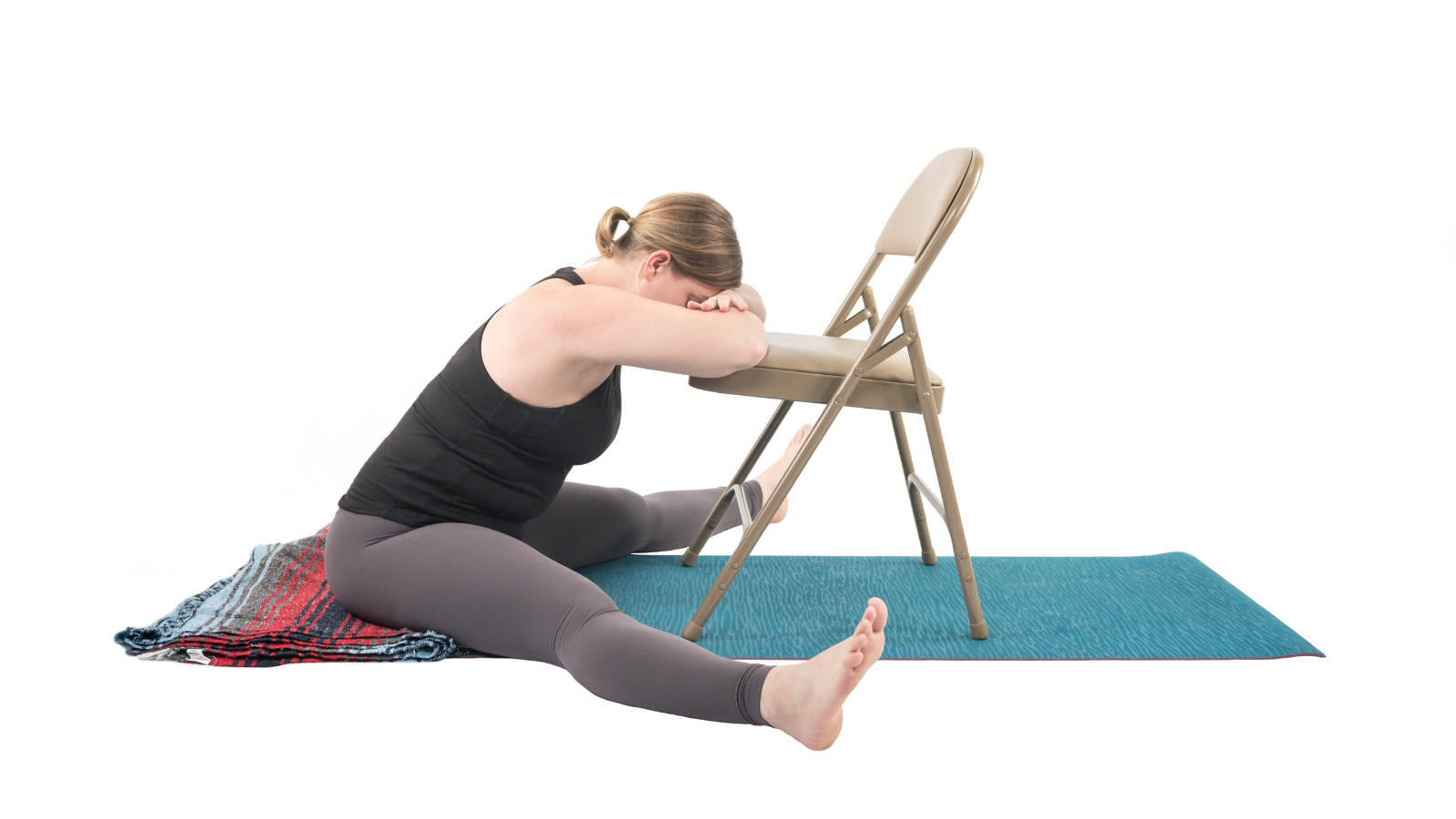
- Bring a chair to your mat, and return to a seat, setting up with folded blankets or a cushion under your sitz bones. Lengthen your legs into a comfortable wide-legged straddle position. Have the seat of the chair facing toward your body. Place rolled-up blankets underneath your knees if the stretch in your hamstrings feels too intense.
- Lengthen through your spine and gently fold forward over the chair, bringing your forehead to meet the seat of the chair. If this feels uncomfortable or unsustainable, place a cushion or rolled-up blankets on top of the seat to make the chair higher.
- If you have additional blankets, you can place one over your lower back or drape one over your shoulders for additional warmth and comfort.
- Stay in this fold for 7 minutes before gently lengthening back into a tall spine.
Restorative Reclining Bound Angle Pose (Supta Baddha Konasana)
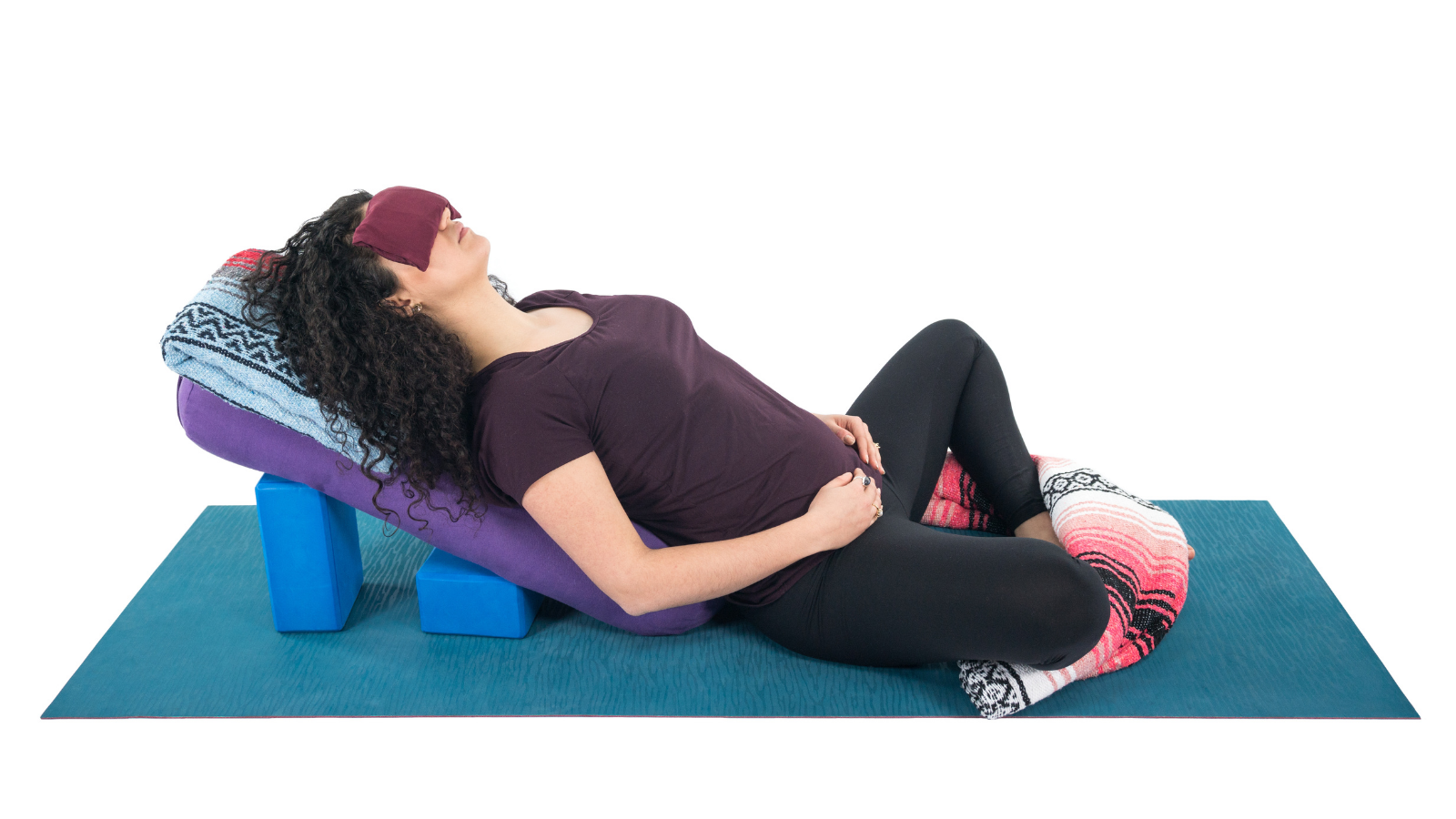
- After completing the second side of the restorative forward bend, gently roll back up to sitting, uncross your legs, and slowly straighten them. Set the chair aside and position your props for Supta Baddha Konasana by setting a bolster to an angle on a second bolster or two blocks set to an incline.
- Bring your sacrum to the base of the bolster, bring the soles of your feet to the touch, and take your knees out wide to create a diamond shape with your legs. Set one rolled-up blanket under the outer sides of each leg for support.
- Slowly recline over the bolster so that your spine and the back of your skull are supported by the prop.
- If available, drape an additional folded blanket across your abdomen. If you have an eye pillow, scarf, or folded cloth, place this across your eyes and envision any stress held in the brow line melting away.
- Stay in Supta Baddha Konasana for about 10 minutes. To ease out of this shape, bring your hands to the backs of your knees to guide them together to touch. Gently roll to your left side, and slowly return to seated. Take a moment to notice the sensation in your body before returning to your day.
Also, read...
4 Yoga Practices to Stimulate the Vagus Nerve
Emerging Research and a Grounding Practice
Do Yoga and Meditation Reduce Health-Care Utilization? What Studies Say
Nov 30 – By: B Grace Bullock, PhD, E-RYT 500
Related courses

Lacey Ramirez writes for YogaUOnline and is an RYT-500 & ERYT-200 yoga teacher, global health researcher, and writer based in St. Louis. Through her work, she seeks to make yoga accessible, inclusive, and equitable.
Lacey discovered yoga as a tool for centering during her years as a competitive runner. Since then, yoga has served as a way to connect with her body throughout her experience of pregnancy and parenthood. She teaches because she hopes others can use this sacred practice for calming, healing, and transformation.
As a yoga teacher, Lacey specializes in teaching restorative, Yin, prenatal, and trauma-informed Vinyasa yoga. She has also completed birth doula and prenatal/postnatal barre certifications and trainings. Additionally, she holds a Masters of Science in Global Health and Population from Harvard T.H. Chan School of Public Health. To learn more and connect, visit her website laceyramirez.com
References
- Domar, A. D. (1996). Stress and infertility in women: Is there a relationship? Psychotherapy in Practice, 2(2), 17-27. Available at https://onlinelibrary.wiley.com/doi/abs/10.1002/%28SICI%291520-6572%28199622%292%3A2%3C17%3A%3AAID-SESS3%3E3.0.CO%3B2-5
- Domar, A. D., et al. (2011). Impact of a group mind/body intervention on pregnancy rates in IVF patients. In Vitro Fertilization, 96(20), P2269-2273. Available at https://www.fertstert.org/article/S0015-0282(11)00476-6/fulltext
- Valoriani, V., et al. (2014). Hatha-yoga as a psychological adjuvant for women undergoing IVF: A pilot study. European Journal of Obstetrics & Gynecology and Reproductive Biology 176, 158-62. Available at https://pubmed.ncbi.nlm.nih.gov/24636596/
- Jasani, S., Heller, B., Jasulaitis, S., Davidson, M., & Hirshfeld-Cytron, J. (2016). Impact of a structured yoga program on anxiety in infertility patients: A feasibility study. Journal of Fertilization, 4(2). Available at https://www.longdom.org/open-access/impact-of-a-structured-yoga-program-on-anxiety-in-infertility-patients-afeasibility-study-2375-4508-1000183.pdf
- Darbandi, S., Darbandi, M., Khorram Khorshid, H. R., & Sadeghi, M. R. (2018). Yoga can improve assisted reproduction technology outcomes in couples with infertility, Alternative Therapies in Health and Medicine, 24(4), 50-55. Available at https://pubmed.ncbi.nlm.nih.gov/29112941/
Recent articles
How to Bend Forward Without Stressing the Spine
Jan 05 – Olga Kabel C-IAYT
Your Brain on Yoga: 4 Ways Yoga May Help Mitigate Cognitive Decline
Jan 01 – Eva Norlyk Smith, Ph.D.
Avoiding the Resolution Blues: How to Make Your New Year’s Resolutions Count
Dec 31 – Eva Norlyk Smith, Ph.D.
Categories
Upcoming courses
Recent articles
Almost there...
Sorry, we couldn't find anything...
Anatomy
How to Bend Forward Without Stressing the Spine
When you go to a yoga class and attempt to do a forward bend,…
Jan 05 – Olga Kabel C-IAYT
Yoga Teaching
Your Brain on Yoga: 4 Ways Yoga May Help Mitigate Cognitive Decline
Can yoga help curb the risk of dementia and Alzheimer’s? A review of 11…
Jan 01 – Eva Norlyk Smith, Ph.D.
Yoga Teaching
Avoiding the Resolution Blues: How to Make Your New Year’s Resolutions Count
Ah – the beginning of a New Year. Like a baby, there’s nothing like…
Dec 31 – Eva Norlyk Smith, Ph.D.



